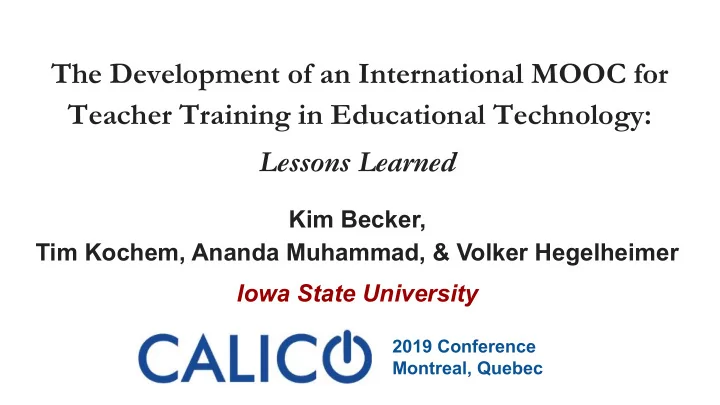

The Development of an International MOOC for Teacher Training in Educational Technology: Lessons Learned Kim Becker, Tim Kochem, Ananda Muhammad, & Volker Hegelheimer Iowa State University 2019 Conference Montreal, Quebec
Topics Covered 1. The design of the MOOC 2. Quality Assurance 3. Using MOOCs for professional development 4. Lessons Learned
Designing the MOOC
Background : The AE e-Teacher Program ● Funded by the U.S. Department of State ● Provides online TESOL teacher training ● Participants nominated by U.S. Embassies ● Global Online Courses (GOCs) ○ 8-week classes with instructors and mentors ○ developed/delivered by academic partners (e.g., ISU) ○ feature free materials (open source content) ● Massive Open Online Courses (MOOCs) ○ facilitated and self-paced MOOCs ○ adapted from GOCs
Transitioning from 8 to 5 Weeks of Content 8-Week GOC 5-Week MOOC Introduction/Overview Introduction/Overview Vocabulary Lexicogrammatical Skills Grammar Reading Literacy Skills Writing Listening Oral/Aural Skills Speaking e-Portfolio Lesson Planning for Technology Integration
Course Instruction ● Written content ● Video instruction ● Slide presentations ● Self-grading quizzes ● Discussion boards ● Self assessments
The MOOC: Technology in the English Language Classroom ● 10,799 enrolled On average, the ● Instructor-facilitated completion rates ○ Respond to Instructor Support Discussion ● 5 weeks for MOOCs is ○ Requires 3-5 hours/week workload about 13% ● Alumni-supported (Onah, Sinclair, & Boyatt, 2014). ○ Respond to discussion posts ● Completion Rate ~30% ○ 2,954 participants completed all modules (~30%) ● Badging ○ 2,427 badged participants (~22%)
Participants’ Badges ● Unique ● Visual ● Shareable ● Verifiable ● Encoded ● Demonstrative
Quality Assurance & Professional Development
High-Performing Alumni Profile ● Nominated by 8-week course instructors ● Criteria ○ digitally literate ○ communicative ○ positive ○ productive ○ interactive ○ motivated ○ responsive
Rationale for Alumni as Facilitators ● Professional development opportunity for GOC alumni ● First-hand understanding of participation ● Helps with high-volume of participants in MOOCs
Training the 14 Alumni Facilitators ● Recruited high-performing alumni from the GOC to be facilitators ● Adapted a model of course facilitation from another AE e-teacher MOOC ● Training and guidance ○ Explaining agreement/disagreement ○ Responding with probing questions ○ Referring back to the readings/videos ○ Handling inappropriate behavior ○ Identifying key themes ○ Dealing with technical issues ○ Maintaining unconditional positive regard ● Scheduling T wo discussions per week ○ ○ Facilitators split time between the two ○ Google sheet for scheduling facilitator presence online
An example of facilitator work: Anwar, Gabi
Discussion Board → HPAF Report → Announcement Discussion Board HPAF Report Course-Wide Announcement ● Participants posted ● Alumni read & ● Lead Facilitator summarized about content and commented on alumni reports replied to peers posts/replies Composed an announcement ● ● Wrote about Synthesized ● quoting both facilitators & experiences themes & quotes participants ●
Example of an Announcement Patricia Smith Hernando Vitrova Sami Eid
The Badge
Alumni Facilitators Survey Results
Lessons Learned
● Course design ● OERs ● Management and coordination ISU Graduate ● Learning about ed tech Students ● Intercultural competence ● Hands-on opportunities Professional Development MOOC Facilitators Participants ● International collaboration ● Assisting fellow teachers ● Reinforcing knowledge
Challenges ● Limited to multiple choice quizzes Assessment 01 ● Discussion forums were optional ● Only exposure to ed tech tools ● 30% completion rate: Good or Bad? 02 Attrition ● Varying student goals ● Over 500 students not badged ● Difficult to integrate skills 03 Adaptation ● Required major changes ● New instructional materials?
Moving Forward ● Facilitated MOOCs ● Increase Alumni Engagement ● Stand-alone MOOCs ● Cascading New Knowledge ● MOOC camps & study groups ● Multiply Program Impact ● Communities of practice
Select References Onah, D. F., Sinclair, J., & Boyatt, R. (2014). Dropout rates of massive open online courses: behavioural patterns. EDULEARN14 proceedings , 5825-5834. Rubio, F., Fuchs, C., and Dixon, E. Language MOOCs: Better by Design. (2016). In Martín-Monje, E., Elorza, I., & Riaza, B. G. (Eds.). Technology-Enhanced Language Learning for Specialized Domains: Practical Applications and Mobility . (177-188). New York: Routledge.
Questions and Contact Kimberly Becker : kpb@iastate.edu AE e-Teacher Program: https://www.aeeteacher.org/
Alumni Facilitators Survey ● Indicative of the most active of the HPAFs (64.3% response rate) ● Survey was submitted anonymously using Google Forms ● Most felt that ... ○ the expectations of their participation were clear ○ they enjoyed the experience ○ they learned as a result ● We asked the HPAFs to reflect about experiences open-endedly: ○ “It gave me the opportunity to collaborate and share with teachers from all over the world. I could reinforce my knowledge about teaching in relation to technology.” ○ “It was absolutely an all new experience. It made me feel true we learn a lot through teaching. Everyone's query made me explore new ventures.” ○ “Freedom of participation. Professional development.” ○ “I liked the fact of working virtually with some other facilitators from different country.” ○ “Helping others and learning from them as well.”
Recommend
More recommend